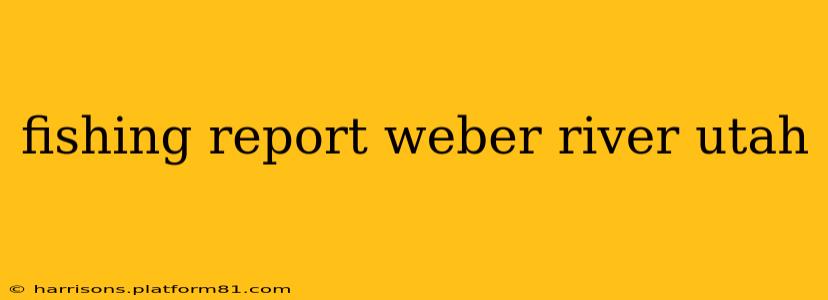The Weber River, a stunning waterway winding through northern Utah, offers anglers a diverse and rewarding fishing experience. This report provides an up-to-the-minute overview of fishing conditions, focusing on species, techniques, and recent catches. Remember to always check current fishing regulations and obtain the necessary licenses before heading out. This information is based on recent reports and observations, and conditions can change rapidly.
What are the best areas to fish on the Weber River?
The Weber River boasts numerous excellent fishing spots, catering to different preferences and skill levels. The upper stretches, near the headwaters, are known for their wild trout populations and challenging terrain. Mid-section areas near towns like Ogden offer more accessible access and a mix of species. The lower river is slower and warmer, attracting different fish species. Specific access points and their current conditions can be found on the Utah Division of Wildlife Resources website. Some popular areas include the Pineview Reservoir outflow, the section near the town of Echo, and the areas closer to the river's mouth near Ogden Bay.
What fish species are commonly found in the Weber River?
The Weber River is home to a variety of fish, making it a diverse and exciting fishing destination. Rainbow trout are the most prevalent, with healthy populations throughout the river. Brown trout are also present, particularly in deeper, slower sections. Cutthroat trout are found in some tributaries and upper reaches. Additionally, the river supports populations of brook trout, and in the lower, warmer sections, you may find smallmouth bass.
What is the current fishing bite like on the Weber River?
Current fishing conditions vary throughout the Weber River due to factors like water temperature, recent weather patterns, and river flow. Recent reports suggest that rainbow trout are actively feeding, particularly on nymphs and smaller streamers. Brown trout are also biting, but often require more finesse techniques like using smaller dry flies or euro nymphing. For the most up-to-date information, I recommend checking local fishing reports, online forums, or contacting local bait shops. They often have firsthand accounts from anglers and can provide current intel on the "bite."
What are the best lures and flies to use in the Weber River?
The best lures and flies depend largely on the time of year and the specific section of the river you are fishing. However, some consistently productive options include:
- Nymphs: These are excellent imitations of aquatic insects, frequently used for trout fishing. Try pheasant tail nymphs, prince nymphs, or copper John nymphs.
- Dry flies: During hatching periods, dry flies can be extremely effective. Look for patterns that imitate mayflies, caddisflies, or stoneflies, depending on the season.
- Streamers: These larger flies are best for targeting larger trout and can be effective throughout the year. Try Woolly Buggers or Muddlers.
- Spinners: In-line spinners and spoons can also be productive, particularly for rainbow trout. Experiment with different colors and sizes.
What are the current fishing regulations for the Weber River?
Fishing regulations for the Weber River are set by the Utah Division of Wildlife Resources (UDWR). It’s crucial to check the UDWR website for the most up-to-date information on bag limits, size restrictions, and any special regulations that might be in place for specific areas or seasons. These regulations are designed to protect the fishery's health and ensure sustainable fishing opportunities for years to come. Always comply with these rules for a responsible and enjoyable fishing experience.
What are some tips for successful fishing on the Weber River?
- Consider the time of year: Water levels and insect hatches vary throughout the year. Research peak seasons for the species you are targeting.
- Check the water flow: High water can make fishing challenging. Check the river flow before you go.
- Respect the environment: Practice Leave No Trace principles and be mindful of other anglers.
- Use appropriate gear: The type of gear needed depends on the fishing technique and the type of fish you are targeting.
This report provides a snapshot of the current conditions on the Weber River. Remember that conditions can change rapidly, so always check local reports and regulations before your trip. Tight lines!
